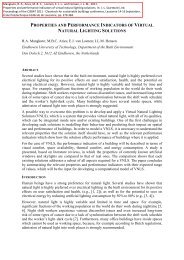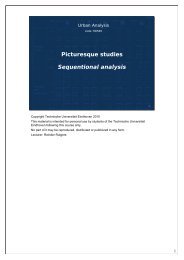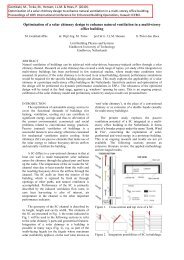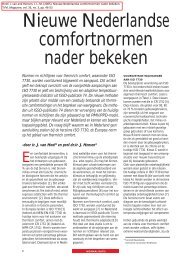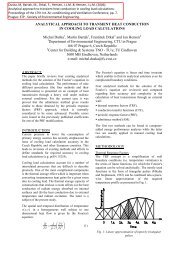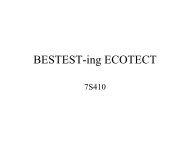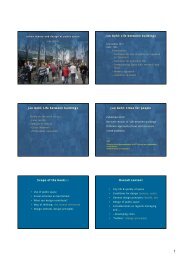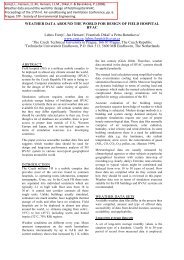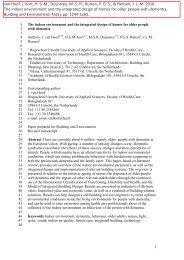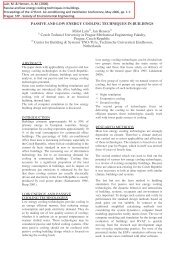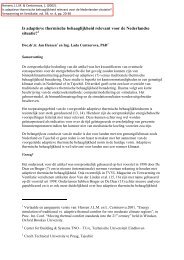literature review on thermal comfort in transient conditions
literature review on thermal comfort in transient conditions
literature review on thermal comfort in transient conditions
Create successful ePaper yourself
Turn your PDF publications into a flip-book with our unique Google optimized e-Paper software.
Literature <str<strong>on</strong>g>review</str<strong>on</strong>g> <strong>on</strong> <strong>thermal</strong> <strong>comfort</strong> <strong>in</strong> <strong>transient</strong> c<strong>on</strong>diti<strong>on</strong>s -7-based) and that there was no clear evidence of an <strong>in</strong>creased or decreased range of acceptableambient temperatures due to fluctuati<strong>on</strong>. An exam<strong>in</strong>ati<strong>on</strong> of Nev<strong>in</strong>s’ raw data however suggests amaximum acceptable peak to peak amplitude of about 2.8 K. This is a little less than the width ofthe <strong>comfort</strong> z<strong>on</strong>e for steady-state c<strong>on</strong>diti<strong>on</strong>s. It should be noted that when unacceptabletemperatures are left out, a rate of temperature change of 19 K/h would have resulted <strong>in</strong> afluctuati<strong>on</strong> frequency of about 3.4 cycles/hour or alternatively 0.9 cycles/hour would haveresulted <strong>in</strong> an average rate of change of 5 K/h.Rohles et al. (1980) c<strong>on</strong>ducted a series of experiments <strong>in</strong> which the subjects (N = 804; collegeage; M = 1.2 met; Icl = 0.6 clo; rh = 50%) were exposed to cyclical changes around various basaltemperatures (17.8 to 29.4 °C) with different amplitudes (1.1 K to 5.6 K) at rates rang<strong>in</strong>g from 1.1K/h to 4.4 K/h (0.3 to 1.5 cycles/hour). The results showed that if (steady-state) temperaturec<strong>on</strong>diti<strong>on</strong>s for <strong>comfort</strong> are met, the <strong>thermal</strong> envir<strong>on</strong>ment will be acceptable, for near-sedentaryactivity while wear<strong>in</strong>g summer cloth<strong>in</strong>g, if the rate of change does not exceed 3.3 K/h and thepeak to peak amplitude is equal to or less than 3.3 K (which is approximately the same as thewidth of the steady-state <strong>comfort</strong> z<strong>on</strong>e). The discussi<strong>on</strong> follow<strong>in</strong>g the presentati<strong>on</strong> of the resultsrevealed some criticism which was acknowledged by the authors. Apparently, their acceptabilitycriteria were less course than usual. Due to the heat capacity of the build<strong>in</strong>g fabric, the meanradiant temperature sw<strong>in</strong>gs were damped and delayed when the air temperature cycled. For thisreas<strong>on</strong>s the acceptable maximum rate of change and peak to peak amplitude of operativetemperature will probably be lower than the values menti<strong>on</strong>ed above.There are a number of difficulties which should be noted when compar<strong>in</strong>g the results of the abovementi<strong>on</strong>ed experiments:• the results are <strong>in</strong> fact subjective resp<strong>on</strong>ses of a highly complex system of which we mostprobably do not yet know all the processes <strong>in</strong>volved to the extent necessary for c<strong>on</strong>troll<strong>in</strong>g allrelevant parameters dur<strong>in</strong>g experiments• usage of different semantic vot<strong>in</strong>g scales, both <strong>in</strong> type (i.e. directed towards acceptance (withwords like acceptable and unacceptable), <strong>comfort</strong>, sensati<strong>on</strong> or mixed) and appearance (e.g. 2, 7 or 9 po<strong>in</strong>t, and discrete or c<strong>on</strong>t<strong>in</strong>uous)• differences <strong>in</strong> acceptability criteria (e.g. <strong>comfort</strong> <strong>in</strong>terval <strong>on</strong> a 7 po<strong>in</strong>t semantic <strong>comfort</strong> scaledef<strong>in</strong>ed as centre-po<strong>in</strong>t ± 1.0 vote as opposed to centre-po<strong>in</strong>t ± 0.5 votes) which is sometimesunavoidable because of the scale differences• differences <strong>in</strong> c<strong>on</strong>diti<strong>on</strong>s: subjects rest<strong>in</strong>g or perform<strong>in</strong>g mental work, fluctuat<strong>in</strong>g dry bulbtemperature or fluctuat<strong>in</strong>g operative temperature• differences <strong>in</strong> subjects; our knowledge of the distributi<strong>on</strong> of thermoregulatory efficiency (andthus the time factor <strong>in</strong> dis<strong>comfort</strong>) am<strong>on</strong>g people is still very limited and this can easily leadto sample errors1) Operative temperatures estimated from given dry bulb temperatures (see text).2) Value at 0.0 cycles/hour <strong>in</strong>dicates width of steady-state <strong>comfort</strong> bandRegardless of these differences all results seem to <strong>in</strong>dicate that with cyclical fluctuat<strong>in</strong>g ambienttemperatures the bandwidth of acceptable temperatures decreases with <strong>in</strong>creas<strong>in</strong>g fluctuati<strong>on</strong>frequency. This bandwidth seems to be at its maximum <strong>in</strong> steady-state c<strong>on</strong>diti<strong>on</strong>s. This can beseen <strong>in</strong> figure 2 which comprises the major results of the experiments and <strong>in</strong>dicates whichfluctuati<strong>on</strong> frequencies were <strong>in</strong>vestigated.The results suggest that there is a certa<strong>in</strong> amplitude threshold (at about 1 K) below which the<strong>in</strong>fluence of fluctuati<strong>on</strong> frequency is negligible. At frequencies below approximately 1.5cycles/hour the maximum acceptable peak to peak amplitude <strong>in</strong>creases with decreas<strong>in</strong>g frequencyuntil the steady-state <strong>comfort</strong> bandwidth is reached.



